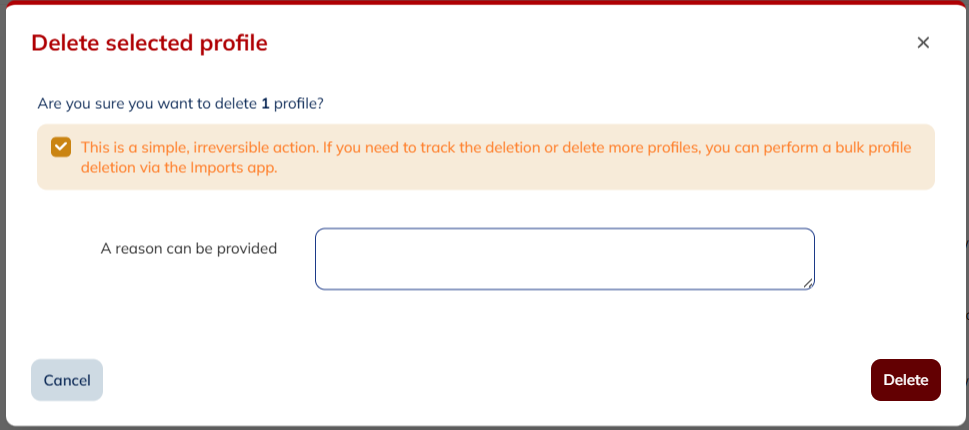Ensuring the Right to Be Forgotten
Any person whose data are being processed has the right to order the data processor to delete their personal information data, as soon as practicable.
This right can be called into action if:
- The person withdraws their consent;
- The person opposes the processing of their data;
- The personal data have been unlawfully processed;
- The personal data are no longer necessary in relation to the purposes for which they were collected.
Deleting a profile will impact data related to it.
Within Actito, there are several ways of removing a profile from the interface.
1. Deleting profiles manually in Actito
Deleting a profile will irreversibly erase all data related to it. Therefore, when deleting a profile, Actito will ask you a to confirm this deletion (as it is final). You will also have the opportunity to provide a reason for this deletion.

The reason provided will be stored in Actito and will be available if extracted by an 'audit trail'.
If you want to obtain an audit trail, please contact your account manager.
It is the responsibility of Actito's client companies ('data controller') to have a good data management policy, and therefore to delete or even anonymize data.
Given the specificities of each sector of activity, and even the specificities of each of Actito's client companies, and in its capacity as subcontractor, Actito cannot take responsibility for setting up standard automatic rules for deleting or anonymizing data present in Actito.
2. Deleting profile using the Actito standards webservices
Actito’s standards APIs allow you to delete a profile. For more information, please take a look at our developpers documentation: https://developers.actito.com/api-reference/menu
3. Deleting profile using a file
Imports and exports can also be implemented in Actito in order to manage the deletion of profiles. This will enable you to synchronize the deletion of profiles with external third parties.
These imports and exports using a file allows you to make bulk deletions in your profile tables.
If you wish to set up an import to allow regular deletion of a list of profiles, please contact your account manager.
4. Repeating the deletion in a third-party system
It is not uncommon for customer databases, stored in Actito, to be dependent on a third-party system managed outside the platform. With this type of configuration, deletion in the Actito interface only makes sense if it is also reflected in these third-party systems.
For this reason, we recommend you to make the deletion in the third-party system and push the demand in Actito.
This means implementing the same process as the one deployed to manage data creation requests and updates.
If you still want to make a deletion via the Actito interface, it is possible to configure a standard daily export containing the profile IDs to be deleted and the time at which the deletion has to be done in Actito. This will enable you to update your system based on the information contained in this export.
5. Anonymizing profile
Within Actito, it is possible to anonymize profiles if you do not want to delete them.
To do so, you have to keep an anonymous ID in Actito (mandatory profile ID) and then overwrite the sensitive data values in Actito (e-mail, surname, first name, etc.).
The overwrite must be configured on your side via the standard data exchange interfaces available in Actito.
This cannot be applied to profile table with e-mail as a primary key, since this information is inherently sensitive.